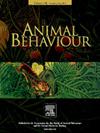Chilled but potent: validating the ability of frozen alarm cues to induce antipredator defences in a freshwater gastropod
IF 2.3
2区 生物学
Q2 BEHAVIORAL SCIENCES
引用次数: 0
Abstract
Damage-released chemical alarm cues released from injured prey serve as an important component of predator–prey interactions in aquatic systems. Other prey can innately recognize these cues, allowing them to reliably estimate the level of risk present in a habitat. Unsurprisingly, researchers widely apply alarm cues across aquatic taxa to study antipredator responses of prey organisms. As alarm cues degrade quickly, scientists often freeze them to retain efficacy over extended periods. While many past studies have successfully used frozen cues to induce antipredator defences, uncertainty remains regarding whether these responses match the magnitude of those elicited by fresh cues. Only rarely have empirical comparisons been conducted between these cues, and in the few instances that have occurred, researchers have primarily assessed short-term behavioural responses. While incorrect short-term responses incur low costs and may thus be triggered by inaccurate cues, the high costs of long-term morphological plasticity should select for greater cue scrutiny. Thus, we comparatively assess both behavioural and morphological responses to these cues and do so for the first time in an invertebrate species, the gastropod Physella acuta. We exposed individuals one time (for behavioural trials) or lifelong (for morphological trials) to either fresh conspecific alarm cues, previously frozen conspecific alarm cues, a fresh water control as well as a previously frozen water control. We then assessed their crawl-out behaviour or their shell thickness, both established antipredator responses in this model system. In line with previous research, exposure to alarm cues induces faster crawl-out behaviour and thicker shells compared to the water control. Furthermore, previously frozen and fresh alarm cues induce comparable responses, suggesting that at least in P. acuta, continuing this convenient practice that also reduces donor animal use does not seem to have unintended consequences.
冷冻但有效:验证冷冻警报提示在淡水腹足动物中诱导反捕食者防御的能力
在水生系统中,受伤猎物释放的损伤释放化学警报信号是捕食者-猎物相互作用的重要组成部分。其他猎物可以天生识别这些线索,使它们能够可靠地估计栖息地中存在的风险水平。不出所料,研究人员广泛地在水生分类群中应用警报线索来研究被捕食生物的反捕食反应。由于警报信号退化很快,科学家们通常会将其冷冻起来,以便在较长一段时间内保持效力。虽然许多过去的研究已经成功地使用了冰冻的线索来诱导反捕食者的防御,但这些反应是否与新鲜线索所引起的反应相匹配仍然不确定。在这些线索之间很少进行实证比较,在少数已经发生的情况下,研究人员主要评估短期行为反应。虽然不正确的短期反应产生低成本,因此可能由不准确的线索触发,但长期形态可塑性的高成本应该选择更严格的线索审查。因此,我们比较评估了对这些线索的行为和形态反应,并首次在无脊椎动物物种中这样做,腹足动物。我们将个体一次性(行为试验)或终生(形态学试验)暴露于新鲜的同种警报提示、先前冷冻的同种警报提示、淡水对照和先前冷冻的水对照。然后我们评估了它们的爬出行为或外壳厚度,两者都在这个模型系统中建立了反捕食者反应。与之前的研究一致,与水控制相比,暴露于警报提示会导致更快的爬出行为和更厚的外壳。此外,先前冷冻的和新鲜的警报提示引起的反应相似,这表明至少在尖尾p.a中,继续这种方便的做法也减少了供体动物的使用,似乎没有意想不到的后果。
本文章由计算机程序翻译,如有差异,请以英文原文为准。
求助全文
约1分钟内获得全文
求助全文
来源期刊

Animal Behaviour
生物-动物学
CiteScore
4.60
自引率
8.00%
发文量
236
审稿时长
10.2 weeks
期刊介绍:
Growing interest in behavioural biology and the international reputation of Animal Behaviour prompted an expansion to monthly publication in 1989. Animal Behaviour continues to be the journal of choice for biologists, ethologists, psychologists, physiologists, and veterinarians with an interest in the subject.
 求助内容:
求助内容: 应助结果提醒方式:
应助结果提醒方式:


